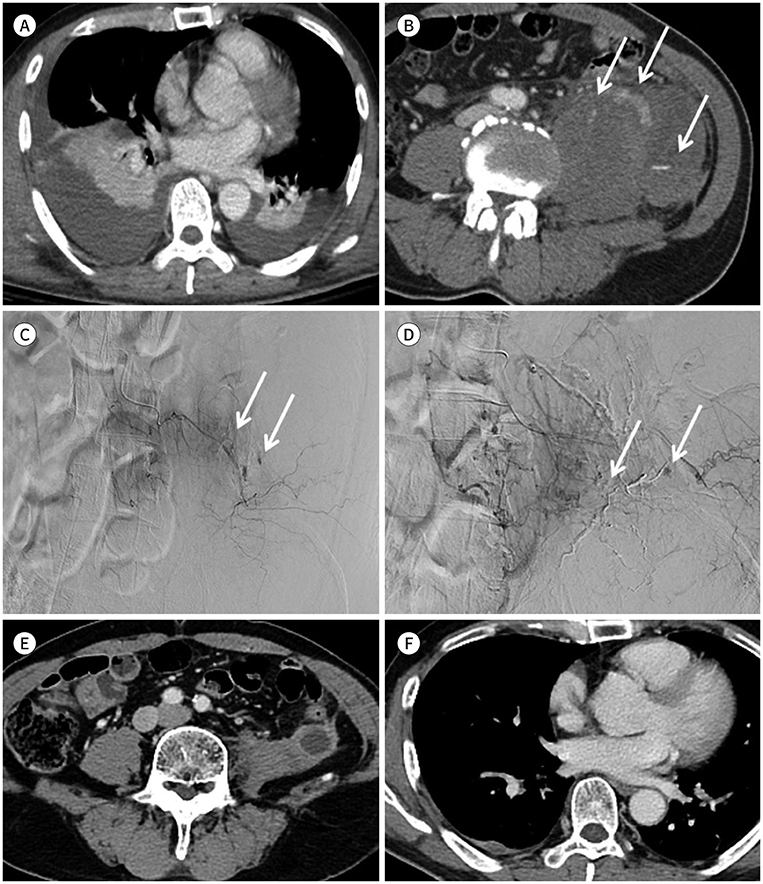J Korean Soc Radiol.
2019 Sep;80(5):963-968. 10.3348/jksr.2019.80.5.963.
The Effectiveness of Interventional Trans-Arterial Embolization to Control Active Bleeding Before Medical Treatment in Patients with Acquired Hemophilia Presenting as Retroperitoneal Hematoma and Hemothorax: A Case Report
- Affiliations
-
- 1Department of Radiology, Severance Hospital, Yonsei University College of Medicine, Seoul, Korea. kdk7118@yuhs.ac
- KMID: 2459022
- DOI: http://doi.org/10.3348/jksr.2019.80.5.963
Abstract
- The author report a case involving a 60-year-old man with acquired hemophilia who presented with sudden-onset left abdominal pain and exhibited retroperitoneal hematoma and hemothorax. In the long term, the patient is being successfully treated with recombinant activated coagulation factor VII. Before this, when the initial active bleeding was detected, successful interventional trans-arterial embolization of the lumbar arteries was performed for immediate hemostasis using N-butyl cyanoacrylate glue and microcoils. This report highlights the effectiveness of immediate interventional trans-arterial embolization in a case of active bleeding in a patient with acquired hemophilia.
MeSH Terms
Figure
Reference
-
1. Lottenberg R, Kentro TB, Kitchens CS. Acquired hemophilia: a natural history study of 16 patients with factor VIII inhibitors receiving little or no therapy. Arch Intern Med. 1987; 147:1077–1081.
Article2. Chan YC, Morales JP, Reidy JF, Taylor PR. Management of spontaneous and iatrogenic retroperitoneal haemorrhage: conservative management, endovascular intervention or open surgery? Int J Clin Pract. 2008; 62:1604–1613.
Article3. Hoots WK. Emergency care issues in hemophilia. Treatment of Hemophilia. Montreal: World Federation of Hemophilia (WFH);2007. p. 43.4. Dzielski T, Nowicka D, Pasz P, Wojciechowska J. Hemothorax and retroperitoneal hematoma with the secondary posthemorrhagic anemia as a complication of oral anticoagulant and non-steroidal anti-inflammatory drug therapy. Pol Merkur Lekarski. 2000; 8:335–336.5. Fan WX, Deng ZX, Liu F, Liu RB, He L, Amrit B, et al. Spontaneous retroperitoneal hemorrhage after hemodialysis involving anticoagulant agents. J Zhejiang Univ Sci B. 2012; 13:408–412.
Article6. Moskovitz B, Braner B, Engel A, Kleinhaus U, Levin DR. Multifocal bleeding due to anticoagulant therapy. Urol Int. 1988; 43:53–55.
Article7. Fukushima T, Mikane T, Ono D, Oku S, Kobayashi H, Watanabe Y, et al. A case of acquired hemophilia A with massive hemothorax. J Anesth. 2012; 26:262–264.
Article8. Franchini M, Gandini G, Di Paolantonio T, Mariani G. Acquired hemophilia A: a concise review. Am J Hematol. 2005; 80:55–63.
Article9. Huth-Kühne A, Baudo F, Collins P, Ingerslev J, Kessler CM, Lévesque H, et al. International recommendations on the diagnosis and treatment of patients with acquired hemophilia A. Haematologica. 2009; 94:566–575.
Article10. Jae HJ, Chung JW, Jung AY, Lee W, Park JH. Transcatheter arterial embolization of nonvariceal upper gastrointestinal bleeding with N-butyl cyanoacrylate. Korean J Radiol. 2007; 8:48–56.
Article
- Full Text Links
- Actions
-
Cited
- CITED
-
- Close
- Share
- Similar articles
-
- Acquired Hemophilia A with Gastrointestinal Bleeding
- Spontaneous Retroperitoneal Hemorrhage Caused by Idiopathic Acquired Hemophilia A Misdiagnosed as a Delayed Traumatic Hematoma: A Case Report
- Arterial Bleeding of a Thyroid Mass After Thyroid Fine-Needle Aspiration Biopsy: A Case Report
- Huge Retroperitoneal Hematoma Following Oblique Lumbar Interbody Fusion
- Interventional and Surgical Treatment of a Hemothorax Caused by a Ruptured Vertebral Artery in a Patient with Neurofibromatosis Type I


